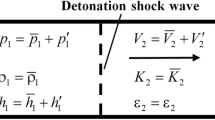Abstract
An approximate analytical model of the flow structure in a plane λ-shaped pseudoshock consisting of a viscous boundary layer and an inviscid core flow is proposed. It is assumed that the boundary layer edge is a streamline with a specified pressure distribution along the channel and that the flow in the pseudoshock consists of an input segment (Mach reflection of an oblique shock wave) and a sequence of internal segments with an identical structure (shock train). Comparisons with experimental data and results of numerical calculations are performed. It is shown that the model provides a sufficiently accurate description of the pseudoshock flow structure.
Similar content being viewed by others
References
Aviation: Encycloperida Ed. by G. P. Svishchev (Bolshaya Rossiiskaya Entsiklopediya, Moscow, 1994) [in Russian].
A. Weiss, A. Grzona, and H. Olivier, “Behavior of Shock Trains in a Diverging Duct,” Exp. Fluids 49(2), 355–365 (2010).
L. Crocco, “One-Dimensional Treatment of Steady Gas Dynamics,” in High Speed Aerodynamics and Jet Propulsion, Ed. by H. W. Emmons (Princeton University Press, Princeton, 1958).
I. Takefumi, M. Kazuyasu, and N. Minoru, “The Mechanism of Pseudo-Shock Waves,” Bull. JSME 17(108), 731–739 (1974).
E. S. Shchetinkov, “Piecewise-0ne-dimensional models of supersonic Combustion and Pseudo-Shock in a Duct,” Fiz. Goreniya Vzryva 9(4), 473–483 (1973) [Combust., Expl., Shock Waves 9 (4), 409–417 (1973)].
T. Kanda and K. Tani, “Momentum Balance Model of Flow Field with Pseudo-Shock,” AIAA Paper No. 2005-1045 (2005).
T. Kanda and K. Tani, “Momentum Balance Model of Flow Field with Pseudo-Shock,” JAXA Res. Develop. Rep. No. JAXA-RR-06-037E (Japan Aerospace Exploration Agency, Tokyo, 2007).
K. Matsuo, Y. Miyazato, and H.-D. Kim, “Shock Train and Pseudo-Shock Phenomena in Internal Gas Flows,” Progr. Aerospace Sci. 35(1), 33–100 (1999).
A. Godbole, “Shock-Assisted Pneumatic Injection Technology,” Ph. D. Dissertation (Wollongong, 1998).
A. Godbole, P. Wypych, W. K. Soh, et al., “Pseudo-Shock in Supersonic Injection Feeder,” in Proc. of the 2nd Int. Conf. on CFD in the Minerals and Process Industries CSIRO, Melbourne (Australia), December 6–8, 1999, pp. 107–112.
A. F. Latypov, “Entropy Maximum Principle for a Steady Gas Flow in a Channel,” Prikl. Mekh. Tekh. Fiz. 52(3), 68–73 (2011) [Appl. Mech. Tech. Phys. 52 (3), 385–389 (2011)].
T. Tamaki, Y. Tomita, and R. Yamane, “A Study of Pseudo-Shock: 1st Report, λ-Type Pseudo-Shock,” Bull. JSME 13(55), 51–58 (1970).
T. Tamaki, Y. Tomita, and R. Yamane, “A Study of Pseudo-Shock: 2nd Report, X-Type Pseudo-Shock,” Bull. JSME 14(74), 807–817 (1971).
E. E. Zukoski, “Turbulent Boundary-Layer Separation in Front of a Forward-Facing Step,” AIAA J. 5(10), 1746–1753 (1967).
D. D. Knight and A. A. Zheltovodov, “Ideal-Gas ShockWave-Turbulent Boundary-Layer Interactions (STBLIs) in Supersonic Flows and Their Modeling: Two-Dimensional Interactions,” in Shock Wave-Boundary-Layer Interactions, Chapter 4, Ed. by H. Babinsky and J. Harvey (Cambridge Univ. Press, New York, 2011), pp. 137–201.
O. V. Gus’kov, V. I. Kopchenov, I. I. Lipatov, et al., Processes of Deceleration of Supersonic Flow in Channels (Fizmatlit, Moscow, 2008) [in Russian].
A. E. Medvedev and V. M. Fomin, “Approximate analytical Calculation of the Mach Configuration of Steady Shock Waves in a Plane Constricting Channel,” Prikl. Mekh. Tekh. Fiz. 39(3), 52–58 (1998) [Appl. Mech. Tech. Phys. 39 (3), 369–374 (1998)].
A. E. Medvedev and V. M. Fomin, “Approximate Analytical Calculation of the Mach Configuration of Steady Shock Waves in a Plane Constricting Channel,” Teplofiz. Aeromekh. 6(2), 157–164 (1999) [Thermophys. Aeromech. 6 (2), 143–150 (1999)].
A. E. Medvedev, “Reflection of an Oblique ShockWave in a Reacting Gas with a Finite Length of the Relaxation Zone,” Prikl. Mekh. Tekh. Fiz. 42(2), 33–41 (2001) [Appl. Mech. Tech. Phys. 42 (2), 211–218 (2001)].
J. Delery, Physical Introduction, Chapter 2, Ed. by H. Babinsky and J. Harvey (Cambridge Univ. Press, New York, 2011), pp. 5–86.
C. A. Mouton, “Transition between Regular Reflection and Mach Reflection in the Dual-Solution Domain,” Ph. D. Dissertation (Pasadena, 2007).
D. J. Azevedo and C. S. Liu, “Engineering Approach to the Prediction of Shock Patterns in Bounded High-Speed Flows,” AIAA J. 31(1), 83–90 (1993).
P. K. Chang, Separation of Flow (Pergamon Press, Oxford, 1970).
L. F. Henderson, “The Reflexion of a Shock Wave at a Rigid Wall in the Presence of a Boundary Layer,” J. Fluid Mech. 30(4), 699–722 (1967).
F. F. Tarasov, “Investigations of the Pseudoshock in Long Channels,” Candidate’ Dissertation in Tech. Sci. (Kazan’, 1967).
F. Billig, “Research on Supersonic Combustion,” J. Propuls. Power 9(4), 499–514 (1992).
L. Lees and B. L. Reeves, “Supersonic Separated and Reattaching Laminar Flows. 1. General Theory and Application to Adiabatic Boundary-Layer/Shock-Wave Interactions,” AIAA J. 2(11), 1907–1920 (1964).
G. I. Petrov, Selected Papers. High-Velocity Aeromechanics and Space Research, Ed. by Yu. V. Chudetskii (Nauka, Moscow, 1992), pp. 146–184 [in Russian].
L. G. Loitsyanskii, Mechanics of Liquids and Gases (Nauka, Moscow, 1978; Elsevier, 1966).
H. Li and G. Ben-Dor, “A Parametric Study of Mach Reflection in Steady Flows,” J. Fluid Mech. 341, 101–125 (1997).
J. C. Dutton and D. F. Carroll, “Numerical and Experimental Investigation of Multiple Shock Wave/Turbulent Boundary Layer Interactions in a Rectangular Duct,” Report Univ. Illinois, No. UILU-ENG-88-4001 (Urbana, 1988).
B. Carroll and J. Dutton, “An LDV Investigation of a Multiple Shock Wave. Turbulent Boundary Layer Interaction,” AIAA Paper No. 89-0355 (1989).
B. Carroll and J. Dutton, “Turbulence Phenomena in Multiple Normal Shock Wave. Turbulent Boundary Layer Interaction,” AIAA J. 30(1), 43–48 (1992).
L. Q. Sun, H. Sugiyama, K. Mizobata, et al., “Numerical and Experimental Investigations on the Mach 2 Pseudo-Shock Wave in a Square Duct,” J. Visual. 6(4), 363–370 (2003).
L. Sun, H. Sugiyama, K. Mizobata, et al., “Numerical and Experimental Investigations on Mach 2 and 4 Pseudo-Shock Waves in a Square Duct,” Trans. Jpn. Soc. Aeronaut. Space Sci. 47(156), 124–130 (2004).
Author information
Authors and Affiliations
Corresponding author
Additional information
Original Russian Text © A.E. Medvedev.
__________
Translated from Prikladnaya Mekhanika i Tekhnicheskaya Fizika, Vol. 55, No. 6, pp. 43–59, November–December, 2014.
Rights and permissions
About this article
Cite this article
Medvedev, A.E. Approximate modeling of the flow structure in a λ-shaped pseudoshock. J Appl Mech Tech Phy 55, 942–956 (2014). https://doi.org/10.1134/S0021894414060054
Received:
Published:
Issue Date:
DOI: https://doi.org/10.1134/S0021894414060054




